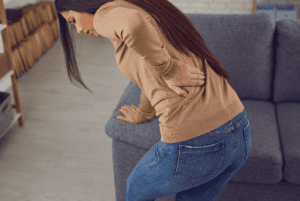Did you know that research suggests 60 to 80% of people experience lower back pain during their lifetime? It’s true.
Also, did you know that lower back pain in females is more common than men? Women also experience more back pain as they age, and the increase in back pain for patients and clients is significant as a woman gets older. Middle-aged women experience back pain for a number of reasons and the more you understand the back pain and what is causing it, the more likely you are to find a way to alleviate the pain.
So what causes lower back pain in females and why do the issues seem to persist?
Many think that inactivity and posture are the main causes of back pain, but there are so many other issues a person can have that will cause pain and discomfort.
Most people will experience some kind of back pain in life, but men are less likely to experience the kind of issues women do for a number of different reasons, and these are just a handful of things that could be giving you a hard time when it comes to back health.

Why Women Might Be Experiencing Back Pain
Menstruation or Uterine Dysfunction
Back discomfort is more common in women who have dysmenorrhea, a uterine abnormality that causes frequent and painful cramping for women during menstruation. Low back pain is a frequent symptom of both the primary and secondary forms of the illness.
Dysmenorrhea begins when a woman starts her period and perpetuates throughout her life. Its harsh and atypical uterine contractions can result in recurrent and severe menstrual cramping.
Dysmenorrhea develops later in life and is brought on by another ailment, such as endometriosis or pelvic inflammatory disease.
Slipped Disc
Spondylolisthesis can occur in the cervical spine, but it most frequently affects the lower lumbar spine, or lower back. Except in circumstances of trauma, it rarely happens in the thoracic spine. The longest segment of the spine, the thoracic, is situated between the cervical and lumbar areas.
Lumbar spondylolisthesis commonly causes localized low back discomfort that comes and goes. When the affected area is flexed or physically touched, the discomfort is even worse.
Endometriosis
Females who have endometriosis may also experience back discomfort as a result of this chronic ailment. The syndrome develops when endometrial-like tissue spreads to the pelvic cavity or other locations outside of the uterus. The dislodged tissue reacts to hormonal changes in the body and can result in swelling, discomfort, spotting between periods, and bleeding.
Because the endometriosis growths bleed like the uterine lining on a monthly basis, the extra fluid causes irritation and inflammation in the surrounding tissue because there is nowhere for the blood to go. As a result, the illness may lead to heavy periods, ongoing pain, and the accumulation of scar tissue.
Symptoms of endometriosis can appear at any point during the menstrual cycle. Most women have pelvic discomfort that travels down their legs, but others also experience gnawing and throbbing pain.
Premenstrual syndrome (PMS)
A hormonal disorder that many women experience prior to their periods, is another hormonal disease that may cause back discomfort in females. Heat and over-the-counter pain relievers are effective home cures for the pain, which typically goes away once menstruation starts.
Spinal Osteoarthritis
Women frequently develop this type of arthritis, which is typically found in the facet joints (vertebrae connectors). Age and/or weight both raise the risk. This happens when the fibrous cartilage in the facet joints breaks down. Bones may collide and rub against one another, resulting in pain in the groin, buttocks, and thighs as well as the upper or lower back. You can get flare-ups on the side of your back when bending in the morning along with discomfort and stiffness.
How To Understand The Cause And Treat Your Lower Back Pain
If you’ve been struggling with back pain for more than a week, it keeps coming back or it’s become more painful, there may be a more serious cause of the problem.
One that walking and other exercises can’t fix.
If this sounds like you, we would love to invite you for a Free Back Pain Assessment, which will enable you to get a full diagnosis and finally understand the real reason your back pain won’t go away!
You can contact us by telephone at 425-658-4944 to claim your Free Back Pain Assessment or by completing our inquiry form in under 30 seconds.
Not sure whether Physical Therapy is right for you?
We appreciate that you may want to find out more and ask some questions about private physiotherapy which is you can arrange a FREE Discovery Session or a FREE Telephone Consultation.
Other Free Resources To Help You With Lower Back Pain
Download our Free Back Pain Guide here and discover 7 incredibly easy ways to get rid of back pain without medication or surgery!
Follow us on social media at Physical Therapy for Everybody Facebook Page and Physical Therapy for Everybody YouTube Channel



